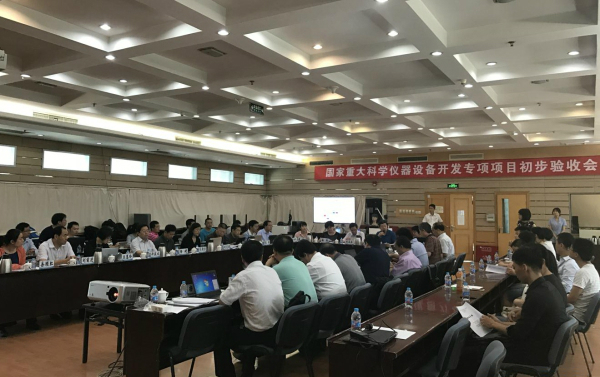[China Instrument Network Instrument R&D] On June 19, the preliminary acceptance meeting of the “photoelectric synchronization brain activity detector†of the major scientific instrument and equipment development project of the Ministry of Science and Technology was held at the Institute of Automation of the Chinese Academy of Sciences.

The project was led by the Institute of Automation of the Chinese Academy of Sciences, and more than 10 research institutes and companies of cooperative development, applied research, and industrialization participated in the conference. The director of the Institute of Automation Brain Network Center, Professor Jiang Tiancai served as project leader. An expert judging panel composed of 12 units from the Ministry of Science and Technology, the Ministry of Industry and Information Technology, Tsinghua University, and the National University of Defense Technology determined that the project passed preliminary acceptance. Deputy Director Cao Ning of the Bureau of Condition Protection and Finance of the Chinese Academy of Sciences and Deputy Director Liu Chenglin of the Institute of Automation of the Chinese Academy of Sciences attended the acceptance meeting.
At the acceptance meeting, Professor Jiang Tiancai introduced the overall situation of the project, and the other 9 units reported on the sub-tasks. The overall goal of the project is the development of photoelectric synchronous brain activity detection instruments. Through the development of instruments, application development, engineering development and industrialization, the objective instrument will be gradually transformed from the engineering prototype to the standard product, and the instrument will be put on the market. It is important for the relevant countries. Scientific and technological projects and scientific research provide technical support.
The project started to start in October 2012. During the four-year project implementation process, the project has successfully developed a high-performance multi-channel near-infrared blood oxygen detection module and developed a high-performance multi-channel EEG acquisition module. The infrared detection module and the brain electrical stimulation module hardware and software platform were built to realize the simultaneous acquisition of near-infrared spectroscopy technology and brain electricity acquisition technology, and truly realized the multi-modal data fusion of brain functional signals. There are many innovations in hardware R&D and software R&D and so on. We have applied for 64 domestic patents, 4 foreign patents, and 21 software copyrights. At present, it has produced 5 channels of photoelectric synchronous brain activity detection system 5 sets, 8 channels of light computer activity detection system 8 sets, and 2 channels of blood oxygen detection wearing 5 sets.
The photoelectric synchronous brain activity detection system developed by the project has been researched in a number of application units. The system has very important value for in-depth study of normal and diseased brain function activities, and can simultaneously acquire neural electrical activity and neuronal electrical activity. Blood oxygen metabolism information meets the major needs of many research institutions and clinical application units. The system has unique advantages in the synchronous acquisition of neural electrical activity and brain metabolism information, and has great social benefits in the clinical application of cognition and major neuropsychiatric diseases.
(Original Title: Development of the National Key Scientific Instruments and Equipment Development "Special Optoelectronic Synchronous Brain Activity Test Instrument Development" Passed Preliminary Acceptance)
![<?echo $_SERVER['SERVER_NAME'];?>](/template/twentyseventeen/skin/images/header.jpg)